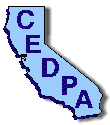
 |
California Educational Data Processing Association |
The DataBus - Vol. 38, No. 1
|
Digital Service: High speeds possible on a single copper pair.
Paul J. Sosa, Pacific Bell
Digital Subscriber line technology has created a buzz in the networking industry. The promise of high speed digital service on a single copper pair is an important step in the provisioning of high speed distributed networks. Digital Subscriber line technology is often referred to as xDSL with the "x" as a placeholder for a number of different implementations.
x DSL technology has three common elements. First, the delivery medium is a single copper telephone pair. Second, the data is formatted digitally. Third, analog voice remains delivered in the 4Khz passband.
ADSL is one implementation of xDSL technology. ADSL delivers an analog voice channel, a digital 384 Kbps upstream channel and a digital 1.5 Mbps downstream channel on a single copper pair.
The explosive growth of the Internet and the expense of hybrid fiber/coax networks has generated a new enthusiasm for ADSL. ADSL's architecture models the traffic patterns on the web. An individual web user clicks on a hypertext link sending a small request to a web server. The server responds with a large HTML file sent in return. The traffic is asymmetric, in that small requests create large responses.
ADSL promises lower cost and higher performance than competing technologies. ADSL uses the existing single pair distribution plant, therefore, is not dependent on costly distribution upgrades. ADSL is a dedicated end user technology, unlike cable modems, that allows the service provider to guarantee performance levels. ADSL is flexible, in that it can be paired with other technologies in the backbone, such as ATM or SONET, to create high speed Wide Area Networks. Finally, ADSL can be configured to carry digital data, analog voice and broadcast MPEG2 video in a variety of implementations to meet customer needs.
Pacific Bell is planning to offer ADSL service in Northern California by the end of 1997 and Southern California early in 1998.